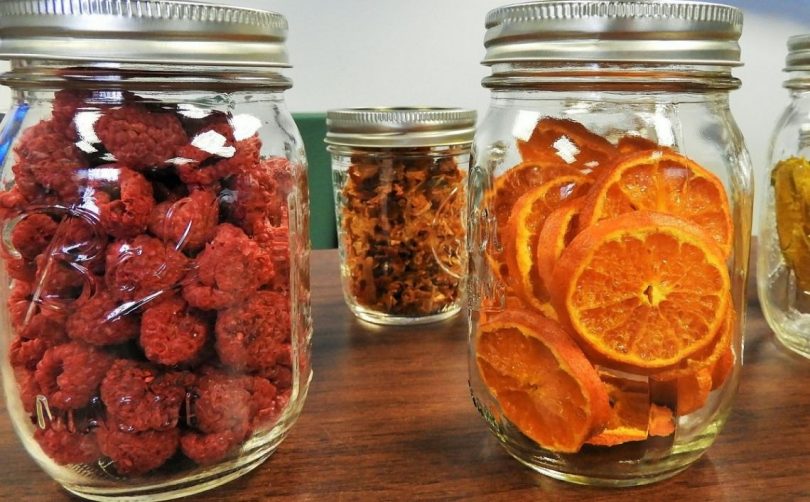The best way to preserve fruits is to dehydrate and dry them. The “life” of dried fruits depends on many factors – one of the important factors is proper storing.
READ ALSO: 6 Food Drying Methods – Pros, Cons and Best Tips
Here is a practical guide on how to store dried fruits at home.
How To Store Dried Fruits at Home
How to package dried fruits?
Dried fruits can easily get contaminated. They should be packed and stored properly to avoid moisture reabsorption.
Things to consider when packaging:
- Warm food may cause sweating, causing moisture, which will grow mold.
- Dried fruits should be packed in dry, clean, and air-tight containers.
- Pack dried fruits in small amounts (serving sizes or what is needed in a recipe). Dried fruits are exposed to air when containers are re-opened, comprising its quality.
- If fruits were subjected to sulfur, put them in a plastic freezer bag first before packing into a metal container. A reaction between the fumes from sulfur and the metal container will cause changes in the fruits’ color.
The best choices for packaging include the following:
- Home canning jars
- Plastic freezer bags
- Plastic freezer containers with lids
- Vacuum packaging
How to store dried fruits?
To store dried fruits, there are three important considerations when choosing a storage area:
Is the area dry?
Is it cool?
Is it dark?
How long do stored dried fruits last?
Recommended storage duration for dried fruits is from 4 months to a year. Food items, including dried fruits, are prone to contamination and the quality is compromised. The quality of the stored fruits is affected because of heat; hence, accurate storage temperatures should be observed at all times.
The temperature of the intended storage area is a huge factor in determining the proper length of storage. Remember, the higher the temperature of the area, the shorter duration for storage.
When properly packed and stored, dried fruits will last for a year, with storage place temperature maintained at 60°F. If stored for 6 months only, the temperature should be at 80°F. Keep in mind that dried vegetables will only have half of the shelf-life of dried fruits.
Exposure to light will compromise the quality of your dried fruits. If store them in your cupboard, expect a shorter shelf-life. The freezer is your best choice. If packed and stored properly, your frozen dried fruits can last up to 1 year.
Constantly check stored dried fruits to make sure that they are still dry.
Important tip: glass jars are your best choice to store dried fruits. You can immediately see if the inside has moisture, you don’t need to open the lid.
If the packed dried fruits have moisture, but not yet spoiled, you should use them at once. If you don’t have any need for them at that instance, you need to repeat the process – dry fruits, then pack.
The moment you notice that condensation appears inside your packed dried fruits, you have to dehydrate and dry them again.
Don’t take risks with moldy dried fruits, discard the package right away.
Store jacks, packs, and plastic bags so that the older items are always positioned in front or on top to make sure that you use the ones that were stored first.
A step-by-step process of storing dried fruits
After learning some facts, then you can go ahead and do this elaborate but enjoyable work. Here is one way to do it:
The preparation
Choose a ripe fruit without blemishes. Wash, peel, take out the seeds and cut into manageable pieces. Cook, steam, or boil it for a couple of minutes. Put into a freezing water bath to halt the process. Then wipe it dry with a paper towel.
Put down the fruit on a tray and drizzle over the sugar water. Leave for five minutes. Then pour the sugar water off and pat again with a paper towel. (Make sugar water by boiling 8 ounces of sugar and 24 ounces of water).
Drying the fruit
For this example, you don’t need any other instruments to dry the fruit. Put down the fruit on a frame of mesh, protect with some kind of netting and let dry in the sun for 4-5 days. Do not leave it out at night. From time to time be sure to turn the fruit so it dries in a uniform way. This process is effective in places with warm weather.
Storing the fruit
Once the fruit dries, put it inside a large container and protect it again with netting. Leave it aside for two weeks. For three days, shake the container a couple of times. This will remove excess moisture and makes it look wrinkly.
Put the finished product in a clear container. Keep in room temperature. You can also store it inside a refrigerator at 0 degrees Fahrenheit for up to 1 year.
Some additional reminders for storing dried fruits
Reiterating important reminders before you begin the process of drying and storing fruits:
- Avoid packing dried fruits for storage before they are completely cool. The air around the warm dried fruit will retain moisture and will be released once it cools. You might find water droplets in the jar, reducing its shelf life.
- Store opened dried fruit containers inside your freezer.
- Use air-tight glass jars or freezer bags for storage. If using the freezer bags, make sure that moisture is released from the bag prior to sealing.
- The best packaging for dried fruits is the vacuum-sealing type. It gives the best shelf life since it effectively removes air. This sealed packaging keeps mold and moisture away from your fruits. If you intend to start a business by selling dried fruits, you should have a vacuum sealer at home.
- Sulfured fruits should be placed in a plastic bag first before placing inside a metal jar.
- Pack dried fruits in small batches. This practice helps maintain their freshness. It also minimizes the risk of contamination. Avoid storing in large quantities in containers, because opening and closing the containers will result in contamination
It is important that you label each of your containers before placing inside the storage area. The date the jar was packaged should appear on the label. This helps prevent spoilage because you can immediately use older items before they lose their freshness.





